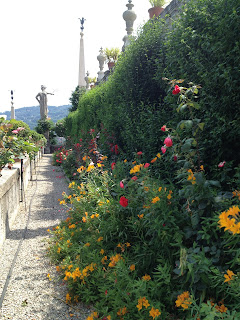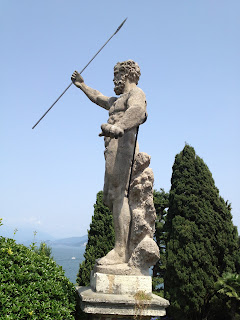 |
| Photo of a napoleon by Flexitarian |
At my gramma’s the breakfast was bacon and eggs and the family story is that she cooked my grampa a pound of bacon a day. A pound of bacon every Sunday — can that be? He died in his sixties, so perhaps it was true. And if the bacon wasn't enough to clog his arteries, then cooking the eggs in pure Crisco surely was. She'd melt a huge dollop of solid Crisco in her frying pan and then when it was good and hot, cracked in the eggs. Those eggs got all crispy crackling brown on the edges and were delicious to eat. If she was out of Crisco — well there was all that bacon fat.
I came from a very frugal family, always saving, never
throwing away much. It was having
parents who grew up during the Depression and never forgot it. They were stuck for life with what I call "Depression-mentality." Always thinking the rug could be pulled out from under you at any moment. Always worrying that something could happen and it would cause your family to go hungry. Again. My father’s mother (who
died before I was conceived) went to the garbage cans behind
restaurants and grocery stores to pull out the thrown-out rotten fruits and vegetables to take home and cook for her family.
On my mother side, the story that epitomized their poignant struggle through the Depression was about my mother’s brother and youngest in the family, Charlie. My Uncle Charlie was what my mother called a "milk-baby." He just loved milk. Milk, milk, milk was what he loved. But milk was not what they could afford when money was tight. So one day, craving his milk, he knew that the way to get it was to go down to the store with a piece of paper from his mother and the milk jug and get it filled to bring home. It wasn't something he ever did on his own; he always went hand-in-hand with my mother or his sister, Maddy, but on this day, hungry for his milk, Charlie climbed down from his chair, got a scrap of paper, the empty jug, and toddled off to the store on his own.
On my mother side, the story that epitomized their poignant struggle through the Depression was about my mother’s brother and youngest in the family, Charlie. My Uncle Charlie was what my mother called a "milk-baby." He just loved milk. Milk, milk, milk was what he loved. But milk was not what they could afford when money was tight. So one day, craving his milk, he knew that the way to get it was to go down to the store with a piece of paper from his mother and the milk jug and get it filled to bring home. It wasn't something he ever did on his own; he always went hand-in-hand with my mother or his sister, Maddy, but on this day, hungry for his milk, Charlie climbed down from his chair, got a scrap of paper, the empty jug, and toddled off to the store on his own.
The grocer (realizing my uncle shouldn’t have come on his own) brought
him back, filled jug in one hand and little Charlie in the other. I was told my grandfather was upset and ashamed. He didn’t want
to owe anyone anything. He didn’t want his family to go without, but he
couldn’t pay for the milk, so, he insisted
the grocer take it back. “Joe, times are
tough — he wants the milk. You’ll pay me
back when things are better,” said the kind man and Charlie got his jug of milk that day.
Breakfast cooked by my mother was simple — eggs with bacon,
ham or Taylor
ham (also known as pork roll up north) or if she was out of all of those, as a
last resort, fried bologna. It wasn't fancy, but she seasoned her eggs with salt, pepper, and onion
powder. That onion powder makes all the
difference. Still as much as I enjoyed those ham and eggs, breakfast wasn't ever
going to be my favorite meal but my husband — my husband is a breakfast-any-time-of-day
guy and breakfast is his favorite meal of any day.
My husband's memories are — lots of buttered hard rolls, eggs with home fries, bacon, maybe a piece of ham steak or kielbasa, and always, always, coffee and crumb cake. When we first stared dating, he took me to the Ideal Cafe in Manhattan, the upper East side around 86th Street in Yorkville — where Germans, Hungarians and other Eastern European groups lived in ethnic clusters — where breakfast was king and could be ordered anytime of day or night, right up until closing. The Ideal was a skinny place with a 40-foot long counter and stools. When the stools were filled with diners, you could barely wedge past to the small raised platform at the building’s end with about six tables, always crammed. The cooks and waiters — all heavy set men in white butchers’ aprons — were slapping things on the grills and shoveling these massive breakfasts on your plate. The Farmer’s Breakfast was his absolute favorite. Eggs cooked with potatoes, onions, peppers and bacon ("an amalgam so solid you could pick it up with your fingers" was how he described it) rye toast, coffee — his kind of culinary heaven. It was sad when The Ideal finally closed down — probably killed off by high rents and changing clientele with stricter dietary requests. No egg-white-only omelettes in this place.
My husband's memories are — lots of buttered hard rolls, eggs with home fries, bacon, maybe a piece of ham steak or kielbasa, and always, always, coffee and crumb cake. When we first stared dating, he took me to the Ideal Cafe in Manhattan, the upper East side around 86th Street in Yorkville — where Germans, Hungarians and other Eastern European groups lived in ethnic clusters — where breakfast was king and could be ordered anytime of day or night, right up until closing. The Ideal was a skinny place with a 40-foot long counter and stools. When the stools were filled with diners, you could barely wedge past to the small raised platform at the building’s end with about six tables, always crammed. The cooks and waiters — all heavy set men in white butchers’ aprons — were slapping things on the grills and shoveling these massive breakfasts on your plate. The Farmer’s Breakfast was his absolute favorite. Eggs cooked with potatoes, onions, peppers and bacon ("an amalgam so solid you could pick it up with your fingers" was how he described it) rye toast, coffee — his kind of culinary heaven. It was sad when The Ideal finally closed down — probably killed off by high rents and changing clientele with stricter dietary requests. No egg-white-only omelettes in this place.
Under that canopy in the Venetian sun, with a simple and lovely breakfast spread, in spite of the Italian splendor around us, my heart and my mouth were watering — for those sunny-side-up crispy crackling eggs fried in Crisco, oh so long ago.























































